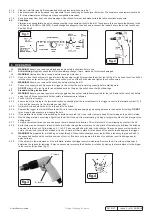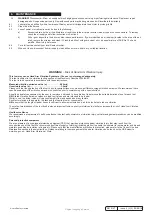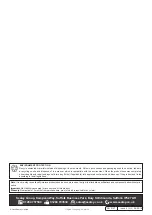
4.1.4.
Clean air inlet filter weekly. Recommended hook-up procedure is shown in fig 1.
4.1.5.
Line pressure should be increased to compensate for unusually long air hoses (over 8 metres). The minimum hose diameter should be
1/4” internal diameter and fittings must have compatible dimensions.
4.1.6.
Keep hose away from heat, oil and sharp edges. Check hose for wear, and make certain that all connections are secure.
4.2.
Couplings.
Vibration may cause failure if a quick change coupling is connected directly to the drill. To overcome this, connect a leader hose to the
drill (Sealey ref: AH2R or AH2R/38). A quick change coupling may then be used to connect the leader hose to the air line recoil hose.
See fig.1& fig.2.
5. OPERATION
WARNING!
Ensure you read, understand and apply safety instructions before use.
5.1.
Drill bit fitting.
Regularly check the drill bit and always change if worn, cracked or otherwise damaged.
WARNING!
Unplug from the air supply before placing bit into chuck.
5.1.1.
Open or close the chuck jaws to a point where the opening is slightly larger than the drill or tool bit (fig.4) to be used. Insert the drill bit
into the chuck as far as it will go. Place the chuck key in one of the chuck holes and tighten the chuck securely.
WARNING!
Ensure you remove the chuck key before starting the drill.
5.2.
Connect air supply to drill. Squeeze the trigger to check that the drill is working correctly before starting work.
8
DO NOT
allow drill to run freely for an extended period of time as this will shorten the life of bearings.
5.3.
Standard drilling instructions.
WARNING!
Ensure you wear approved safety goggles and any other safety items required for the job. Remove the chuck key before
using the drill. Also ensure that all other safety requirements are followed.
5.3.1.
Connect drill to air supply.
5.3.2.
Ensure the drill is turning in the forward direction by checking that the lever adjacent to the trigger is next to the forward symbol (F). If
not, push the lever over to the forward position (fig.3).
5.3.3.
Hold tool firmly and place the bit tip to the point to be drilled.
5.3.4.
Depress the trigger to start drill. Move the drill bit into the work piece applying only enough pressure to keep the bit cutting.
DO NOT
force or apply side pressure to elongate the hole.
5.3.5.
If the material to be drilled is free standing it should be secured in a vice or with clamps to keep it from turning as the drill bit rotates.
5.3.6.
When drilling metals, use cutting a light oil on the drill bit to keep it from overheating. Cutting oil will prolong life of bit and improve the
drilling action.
5.3.7.
For hard smooth surfaces use a centre punch to mark desired hole location. This will prevent bit from slipping as you start to drill.
5.3.8.
A pilot hole may be necessary to assist the final drill size through the work piece. Lock a pilot drill (smaller size drill than the finished
hole size) into the chuck. Follow steps 5.3.1. to 5.3.3. above and drill a pilot hole in the middle of the centre punch mark where final
hole is to be drilled. Insert the final sized bit in chuck. Hold drill firmly, place bit at entrance of the pilot hole and depress the trigger.
WARNING!
Be prepared for drill binding on break through. When these situations occur the drill has a tendency to grab and kick in
the opposite direction which could cause loss of control. If you are not prepared, this loss of control can result in damage and/or
personal injury.
5.3.9.
If the bit jams in the workpiece or if the drill stalls, release the trigger switch immediately. Remove the bit from the workpiece and
determine the reason for jamming. It may be necessary to reverse the direction of rotation by moving the lever adjacent to the trigger
to the reverse (R) position (fig.3).
Original Language Version
© Jack Sealey Limited
fig.1
fig.2
“R” reverse
“F” forward
fig.4
fig.3
S010147 Issue 2 (H, F) 09/05/18






















